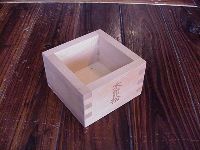 Many people have had the experience of drinking sake from a small wooden box, often with a pinch of salt on one corner. We may hear that this is one traditional way to drink sake. What is behind this custom?
Many people have had the experience of drinking sake from a small wooden box, often with a pinch of salt on one corner. We may hear that this is one traditional way to drink sake. What is behind this custom?
Those small boxes are known as masu, and were long ago used very commonly to drink sake. The wood they are made of is sugi, sometimes called Japanese cedar, but more correctly cryptomeria.
Originally, they were actually a measure of rice (about one meal’s worth), and as they were readily available and cheap, they came into use as drinking vessels as well, especially at the sake pubs of olde. The volume these masu hold eventually came to be the standardized single serving volume: 180 milliliters (just about 5.5 ounces).
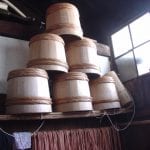 Since sake long ago was fermented in wooden tanks, and stored in wooden casks, the woody notes that might be imparted by serving in a masu might not be so noticeable. But having said that, even when wooden tanks were used (or are used, as there is a mini-renaissance of wooden tanks these days), there were aired out and used for water or rice first, to blow off the woody smells. So wooden tanks did not likely overdose the sake with woody essences. But then yet again, sake back 100 years ago was heavier, richer and often sweeter than the sake of today.
Since sake long ago was fermented in wooden tanks, and stored in wooden casks, the woody notes that might be imparted by serving in a masu might not be so noticeable. But having said that, even when wooden tanks were used (or are used, as there is a mini-renaissance of wooden tanks these days), there were aired out and used for water or rice first, to blow off the woody smells. So wooden tanks did not likely overdose the sake with woody essences. But then yet again, sake back 100 years ago was heavier, richer and often sweeter than the sake of today.
Which is why the refined and comparatively delicate sake of today is perhaps better off served in some other vessel, one that is decidedly neutral and that will not impart aromas of any kind to the sake. As modern sake is brewed in porcelain-lined steel tanks, the woody scents of long ago have now been replaced by fruit, flowers, and a whole host of other aromas. It would hardly be fair to the brewers to force these to compete with the woody influence of a masu!
There are, by the way, lacquered masu that allow one to enjoy the traditional feel of drinking from a masu, while enjoying the fruits (no 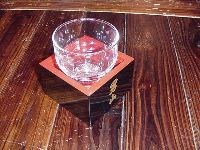 pun intended) of modern sake brewing skills. (Actually, most of them are plastic, i.e. “genuine artificial lacquerware,” but I digress.)
pun intended) of modern sake brewing skills. (Actually, most of them are plastic, i.e. “genuine artificial lacquerware,” but I digress.)
The pinch of salt on the corner is interesting as well. According to one source (there are sure to be many opinions), the salt should not be placed just on the corner, but a bit to the side of it, so that when one drinks, the salt touches the corner of the lips, not dead center. This allows the sake to be the main flavor, with the salt on the side. Note, the salt should not be allowed to fall into the sake.
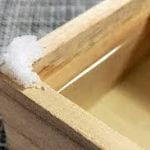 Why salt? According to the same source (a historian at one of the large breweries in Japan), the salt was more for the proprietor than the consumer. Salt is often used in purification rituals in Japan, as well as for good luck in drawing customers to places of food and drink. Apparently this superstition was one big reason for putting the pinch of salt on the edge of the masu. But again, there are sure to be other interpretations.
Why salt? According to the same source (a historian at one of the large breweries in Japan), the salt was more for the proprietor than the consumer. Salt is often used in purification rituals in Japan, as well as for good luck in drawing customers to places of food and drink. Apparently this superstition was one big reason for putting the pinch of salt on the edge of the masu. But again, there are sure to be other interpretations.
Also, as mentioned above, a century ago and earlier sake was bolder and often sweeter, and simple things like salt and miso were often used as snacks while drinking. A bit of salt was also thought to stimulate the appetite and make the sake itself more enjoyable, a sentiment with which I will readily agree.
Also, not all sake today is light and ephemeral. If anything, traditional heavier types, like kimoto, yamahai, and just plain big-ass sake, are making much more visible these days, which is great. It increases the veritable variety of proper sake that available to us all. And on the food side, there are certainly much more enjoyable food and snacks for sake today than just a pinch of salt, although such simplicity certainly has its place.
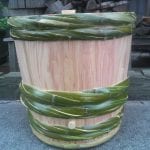 There is, however, one time and one type of sake for which masu and salt are still commonly used today. Just after New Year’s Day, when people gather for traditional year-opening ceremonies in communities, families and companies, taru-zake is often the sake of choice. Taru-zake is sake that has been stored in the traditional cedar cask, not bottles, deliberately to induce that woody taste and aroma. While it may not be as hoity toity as a fine ginjo, taru-zake has its charm and appeal, and is perfectly enjoyable.
There is, however, one time and one type of sake for which masu and salt are still commonly used today. Just after New Year’s Day, when people gather for traditional year-opening ceremonies in communities, families and companies, taru-zake is often the sake of choice. Taru-zake is sake that has been stored in the traditional cedar cask, not bottles, deliberately to induce that woody taste and aroma. While it may not be as hoity toity as a fine ginjo, taru-zake has its charm and appeal, and is perfectly enjoyable.
This is precisely when wooden masu are used, with woody sake, and this is when even today we can enjoy a good, strong-flavored sake with a pinch of salt on the corner of the masu.
Should it be available near you, bring in 2021 with a tad of sake tradition, and a prayer for peace and joy on the planet. Prepare for that now by procuring a few masu and some taruzake. The salt? You likely have that on hand already!
~~~~~~~~~~~~~~~~~~~~~~~~~~~~~~~~~~~~~~~~~~~~~~~~~~~~~~~~~~~~~~~~~~~~~~~~~~~~~~~~~~~~~~~~~~~
 Know more. Appreciate more.
Know more. Appreciate more.
Interested in learning more about sake, and the industry in Japan that makes it? Subscribe to Sake Industry News, a twice-monthly newsletter covering news from within the sake industry in Japan. Learn more and read a few sample issues here.







